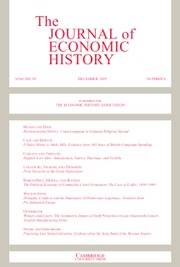Article contents
An Alternative Institutional Approach to Rules, Organizations, and Development
Published online by Cambridge University Press: 19 May 2022
Abstract
In the middle of the nineteenth century, a handful of societies began creating and enforcing impersonal rules, rules that treat everyone the same, on a broad scale. The existing institutional literatures, while appreciating the importance of impersonal rules for the rule of law, have not understood how they contribute to economic and political development through rules that are enforced but not followed: default rules. The conceptual importance of impersonal default rules is drawn out and then applied to better understand both economic and political development in the late nineteenth and early twentieth centuries.
- Type
- Article
- Information
- Copyright
- © The Author(s), 2022. Published by Cambridge University Press on behalf of the Economic History Association
Footnotes
The seeds for this paper were planted many years ago in conversations with Doug North and Barry Weingast, to whom I am always grateful. Steve Webb helped those ideas mature. The specifics of this paper blossomed in conversations with Peter Murrell, Felipe Safie, Christopher Morris, and Brian Kogelman, particularly the day that Peter and Felipe pointed out that my ideas about political parties were much more important than I recognized. Doug Allen, Eric Alston, Lee Alston, Price Fishback, Ron Harris, Sumner LaCroix, Naomi Lamoreaux, and Jean-Laurent Rosenthal gave me great comments on earlier drafts, as did the editors, Dan Bogart and Eric Hilt. All of these people and their work have shaped my ideas. Jean-Laurent bears particular responsibility for challenging me to distinguish my ideas on institutions from the existing literature, which this paper starts to do. Naomi and I have been working on a long, slow, steady project on the history of American democracy, which has framed my thinking for the last decade. Thank you all. The mistakes are, obviously, mine.
References
REFERENCES
- 1
- Cited by




